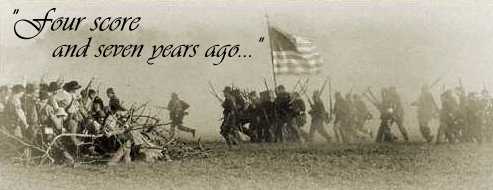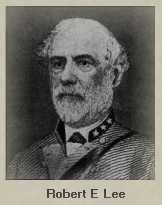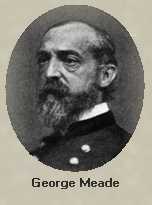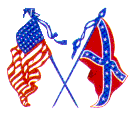

 In June of 1863 General Robert E Lee's Army of Northern
Virginia had been victorious at Chancellorsville.
Encouraged by that victory, the army forged westward
from Fredericksburg, through the gaps in the
Blue Ridge Mountains, and north into Maryland and
Pennsylvannia.
In June of 1863 General Robert E Lee's Army of Northern
Virginia had been victorious at Chancellorsville.
Encouraged by that victory, the army forged westward
from Fredericksburg, through the gaps in the
Blue Ridge Mountains, and north into Maryland and
Pennsylvannia.
The Army of the Potomac, newly led by General George Meade,
followed Lee. The two armies met, by chance, at Gettysburg.

On July 1 the Confederates attacked the troops on McPherson Ridge, west of town. The Union troops, held until the afternoon, but were overpowered and driven back to Cemetery Hill.
On July 2 the battle lines were drawn up in two sweeping arcs. The main bodies of both armies were nearly a mile apart on parallel ridges, the Union forces on Cemetery Ridge and the Confederates on Seminary Ridge.
Both Union flanks were attacked. General James Longstreet's thrust on the Union left cleared Union troops from Devil's Den, turned the base of the hill called Little Round Top into a shambles, left the Wheat Field littered with dead and wounded, and overran the Peach Orchard. Colonel Joshua L Chamberlain led a successful defense of the extreme left flank of Little Round Top.

"They have hammered us into a solid position they cannot whip us out of."
 On July 3, Lee's artillery opened a two-hour bombardment of the
Union lines on Cemetery Ridge and Cemetery Hill. Union
cannon responded, resulting in the longest cannonade of the
Civil War.
On July 3, Lee's artillery opened a two-hour bombardment of the
Union lines on Cemetery Ridge and Cemetery Hill. Union
cannon responded, resulting in the longest cannonade of the
Civil War.
After the large guns were silent, Gen George Pickett and his 12,000 troops made their fateful charge across a one mile open field toward the center of the Union line. Only 1 in 3 returned. General Robert E Lee's final attempt to move the war to the North had failed. When the attack was repelled,the Battle of Gettysburg was over.
 The third day of the Gettysburg battle, July 3, 1863, is
considered the high water mark of the Confederacy.
The third day of the Gettysburg battle, July 3, 1863, is
considered the high water mark of the Confederacy.
In three days the armies had suffered a total of 51,000 casualties, including dead, wounded and missing men.
On that same day, many miles to the south, General Ulysses S Grant was accepting the surrender of Vicksburg, Ms. The North now controlled the Mississippi River, splitting the Confederacy in two. Lee's army staggered back into Virginia. He would never again mount a comparable offensive.
George Meade was sharply critized for not pursuing Lee into Virginia and ending the war. In part because of his shortcomings at Gettysburg, he was replaced as Commander of the Potomac by Grant, who had been promoted to Lieutenant General.
The Battle of Gettysburg is often seen as the turning point of the Civil War from both perspectives. The South would never recover from the physical and psychological blows they received in those three days. The North only grew stronger from their victory and the leadership of Grant, whose policy was to continue forward after a battle, not retreat, like all former generals of the Federal Army had done.
Back to Copperline main page